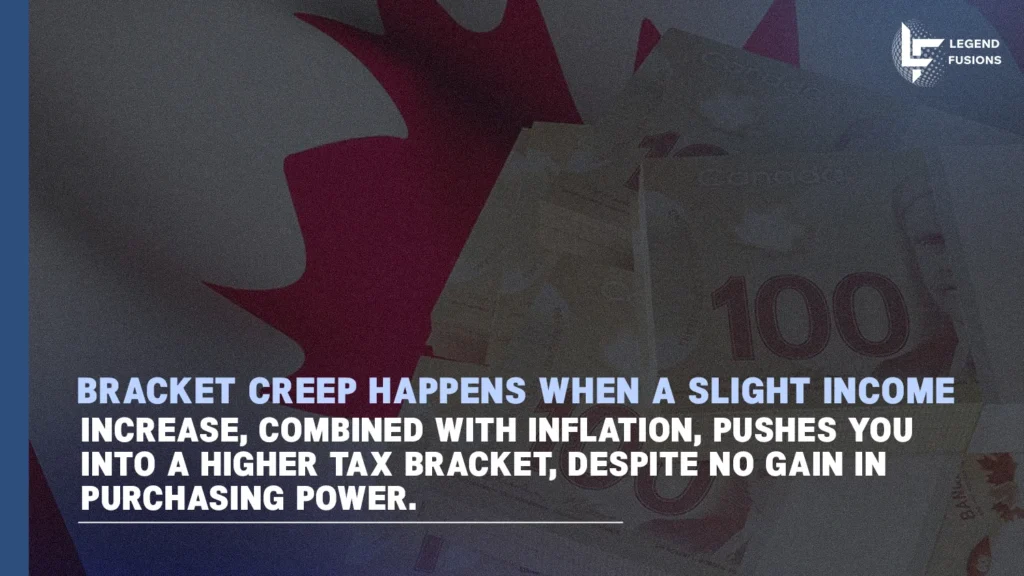Tax season might not be the most exciting time of year. But understanding where your income falls in the Canada Tax Brackets for 2025 can make a big difference in how much you owe or save.
In this guide, you’ll get a clear breakdown of federal and provincial/territorial tax brackets. We’ll walk you through what’s changed and how to figure out where your income falls into. If you want to hold onto more of your hard-earned money, knowing your tax bracket is the first step. Let’s get into it.
Contents
What Are Canadian Income Tax Brackets?
Canada uses a progressive tax system, which means the more you earn, the higher the tax rate you’ll pay. So, you’re not taxed at your highest rate on your entire income.
Each year Canada’s tax brackets change due to indexation or sometimes government policies. Indexation adjusts income thresholds to keep up with inflation and helps prevent what’s known as “bracket creep.”

Federal vs. Provincial/Territorial Tax Brackets
In Canada, income tax has two layers:
- Federal Tax
- Provincial or Territorial Tax
The Canada Revenue Agency (CRA) handles federal taxes and also manages most provincial and territorial taxes—except in Quebec, where a separate agency operates.
Each province and territory sets its own tax brackets and rates on top of the federal ones. So, where you live has a direct impact on how much tax you pay overall.
The 2025 Federal Income Tax Rates and Thresholds
For the 2025 tax year, the federal income tax brackets in Canada have been adjusted to account for inflation, with a 2.7% indexation factor applied. The updated federal tax rates and corresponding income thresholds are as follows:
- 15.0% on the first $57,375 of taxable income
- 20.5% on the portion of taxable income over $57,375 up to $114,750
- 26.0% on the portion over $114,750 up to $177,882
- 29.0% on the portion over $177,882 up to $253,414
- 33.0% on any taxable income exceeding $253,414
Note: A legislative change announced in May 2025 will reduce the lowest federal tax rate from 15% to 14%, effective July 1, 2025. This change is part of a broader tax relief initiative aimed at benefiting middle-income earners.
Federal Basic Personal Amount for 2025
BPA is the non-refundable tax credit that can be claimed by all individuals. It has also been adjusted for inflation. For the 2025 tax year, the BPA is set at $15,705. This means that individuals can earn up to this amount without paying federal income tax.
Provincial and Territorial Tax Brackets 2025
1. Ontario
For 2025, Ontario’s provincial income tax brackets are:
- 5.05% on the first $52,886 of taxable income
- 9.15% on the portion over $52,886 up to $105,775
- 11.16% on the portion over $105,775 up to $150,000
- 12.16% on the portion over $150,000 up to $220,000
- 13.16% on income over $220,000
Ontario also applies a surtax on higher-income individuals, which increases the effective provincial tax rate for those affected.
Learn how to calculate Ontario tax in our step by step guide.
2. Quebec
Quebec administers its own personal income tax system, separate from the federal system. The 2025 provincial tax brackets are:
- 14% on the first $53,255 of taxable income
- 19% on the portion over $53,255 up to $106,495
- 24% on the portion over $106,495 up to $129,590
- 25.75% on income over $129,590
It’s important to note that Quebec residents must file separate federal and provincial tax returns.
3. Alberta
Alberta’s 2025 tax brackets are:
- 8% on the first $60,000 of taxable income
- 10% on the portion over $60,000 up to $151,234
- 12% on the portion over $151,234 up to $181,481
- 13% on the portion over $181,481 up to $241,974
- 14% on the portion over $241,974 up to $362,961
- 15% on income over $362,961
The introduction of the 8% bracket for income up to $60,000 provides tax relief for lower-income earners.
4. British Columbia
British Columbia’s 2025 tax brackets are:
- 5.06% on the first $49,279 of taxable income
- 7.7% on the portion over $49,279 up to $98,560
- 10.5% on the portion over $98,560 up to $113,158
- 12.29% on the portion over $113,158 up to $137,407
- 14.7% on the portion over $137,407 up to $186,306
- 16.8% on the portion over $186,306 up to $259,829
- 20.5% on income over $259,829
These brackets are indexed annually to reflect changes in the cost of living.
How to Figure Out Your Tax Bracket in Canada
Understanding your tax bracket helps you plan how much income tax you owe and leads to smart financial decisions. Here’s a simplified step-by-step process:
- Determine Your Taxable Income
Start with your total income from all sources (employment, business, investments, etc.). Subtract deductions such as RRSP contributions, child care expenses, and union dues to calculate your net taxable income. - Apply Federal Tax Brackets
Refer to the federal tax brackets for 2025 and see where your income falls. Only the income above each bracket threshold is taxed at the higher rate—not your entire income. - Apply Provincial/Territorial Tax Brackets
Based on your province or territory of residence, apply the relevant local tax brackets. You’ll be taxed at both federal and provincial/territorial levels. - Account for Tax Credits
Subtract non-refundable tax credits (like the basic personal amount) from the taxes owed to reduce your final bill. - Consider Other Deductions and Surtaxes
Depending on your income level and province, additional surtaxes or deductions (like medical expenses or charitable donations) may apply.
B. Marginal vs. Effective Tax Rate
Marginal Tax Rate is the highest rate at which your income is taxed. For example, if you earn $110,000, your top federal rate may be 26% (only on the portion over $111,733).
Effective Tax Rate is the average rate you pay on your entire income. It’s calculated by dividing total taxes paid by total taxable income. This rate is always lower than your marginal rate due to Canada’s progressive tax system.
Strategies to Optimize Your Tax Bracket in 2025
Understanding how tax brackets work is one thing, putting that knowledge to use is another. With a few smart strategies, you can reduce your taxable income, stay in a lower bracket, and make the most of your hard-earned money.
A. Make Use of Registered Accounts
1. RRSP Contributions
Contributing to your Registered Retirement Savings Plan (RRSP) is one of the most effective ways to reduce taxable income. The amount you contribute is tax-deductible, which means it can bring your income down into a lower bracket. You’ll pay tax later when you withdraw the money, ideally in retirement, when your income (and tax rate) may be lower.
2. TFSA Investments
While Tax-Free Savings Account (TFSA) contributions don’t reduce your taxable income, they do allow your investments to grow tax-free. Withdrawals are also tax-free, making TFSAs a powerful tool for long-term savings without affecting your current tax bracket.
B. Take Advantage of Tax Credits
Non- refundable tax credits, like the Basic Personal Amount, Canada employment amount, and tuition credits, can reduce the amount of tax you owe. While they won’t lower your taxable income, they do reduce your overall tax burden.
C. Time Your Income Strategically
If possible, consider deferring income, for example, delaying a year-end bonus to the following year, especially if you expect to be in a lower bracket later. Similarly, capital gains and withdrawals from registered accounts can sometimes be timed to minimize the tax hit.
D. Split Income Where Allowed
For couples, income splitting through pension income or spousal RRSPs can help shift income from a higher-earning spouse to a lower-earning one. This strategy can lower your overall family tax burden and keep more income in lower brackets.
E. Maximize Deductions
Be sure to claim all available deductions, including:
- Childcare expenses
- Moving expenses (if eligible)
- Union and professional dues
- Interest on student loans
- Self-employment expenses
Each deduction lowers your taxable income, helping you stay in a more favorable bracket.
F. Consider Capital Gains and Dividends
Different types of income are taxed differently. Only 50% of capital gains are taxable, and eligible dividends receive preferential tax treatment due to the dividend tax credit. By diversifying how you earn income, you can reduce your effective tax rate.
FAQs
Tax brackets apply to your taxable income, not your gross income. This means that deductions (like RRSP contributions or union dues) and non-taxable benefits are subtracted from your total income before determining which bracket(s) you fall into.
No, moving into a higher tax bracket only increases the rate on the additional income, not on your entire earnings. Canada’s tax system is progressive, so you always keep more of what you earn, even when you move into a higher bracket.
Canada does not offer joint tax filing like the U.S. Each individual files separately. However, some credits and benefits (like spousal amounts and pension income splitting) can be transferred or shared between partners to optimize taxes.
You’re generally taxed based on your province of residence on December 31 of the tax year. Even if you earned income elsewhere, that province’s tax brackets won’t apply unless you were considered a resident there at year-end.
Benefits like the CCB are income-tested. This means your taxable income affects how much you receive. As your income rises through the tax brackets, certain benefits may be reduced or clawed back, making tax planning even more important.
Making the 2025 Tax Brackets Work for You
Knowing Canada’s tax brackets 2025 let’s you plan ahead in the face of new income thresholds, inflation adjustments, and province-specific rules. When you don’t understand where your money’s going, it’s harder to make smart choices.
At Legend Fusions Canada, we help individuals, families, and businesses navigate these complexities with clarity and confidence. We share 12+ years of legacy with our UK-servicing sister firm, establishing a solid foundation of authority and credibility.
Get in touch with Legend Fusions today and make your 2025 tax season your most efficient yet.

Jeffrey Ross
Jeffrey Ross is an experienced tax accountant focused on US-Canada cross-border taxation, with over three years in the industry, including a key role as client manager at a Canadian tax firm. He provides expertise in corporate and personal tax planning, specializing in non-resident tax, capital gains, CRA and IRS compliance, and retirement planning. Known for his personalized approach, Jeffrey is dedicated to guiding clients with clear, practical advice tailored to complex tax scenarios, aligned with the evolving tax laws.

